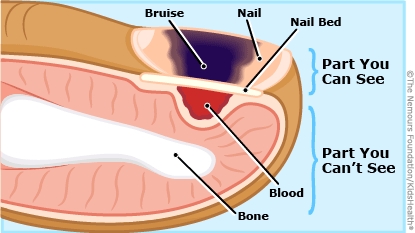Blood Under a Nail: How to Care for Your Child
A subungual hematoma is a common and painful childhood injury. The pain is caused by blood under a fingernail or toenail, and usually goes away after the blood is drained.


A subungual hematoma is blood trapped under a fingernail or toenail, often due to an injury such as a stubbed toe or a finger slammed in a door. The injured area under the nail bleeds and, as a result, turns a blue-black color. A child with a subungual hematoma might feel a throbbing pain under the nail, which often becomes worse as the blood spreads.
The health care provider examined your child's nail to see if the nail is still intact and if the finger or toe had any other injuries. If the nail itself was severely injured, it may have been removed. Otherwise, the health care provider performed a procedure called "trephination." This involves putting a tiny hole in the nail and draining the blood trapped beneath it. This relieved the pressure under the nail and helped your child's pain improve quickly.
The health care provider wrapped your child's finger or toe in a bandage, and might have placed a splint to protect the area if there were other injuries to the finger or toe.

-
Soak your child's finger or toe in warm, soapy water three times a day for the next two days. Be sure to keep the bandage on between soaks.
-
Some drainage of blood from the small hole is normal.
-
Follow the health care provider's directions for putting bandages on the injured area
-
If your child also has a broken bone or a lot of swelling or pain, placing ice wrapped in a towel over the injury will help the swelling and pain. Hold ice in a towel against the finger or toe for 15-20 minutes every 3-4 hours for the next 48 hours.
-
If the finger or toe is very swollen, raise it above the heart level by propping it up on a pillow as much as possible in the first few days.
-
If a splint was placed, follow the health care provider's directions for caring for the splint.
-
For pain, you may give acetaminophen OR ibuprofen, if recommended by your health care provider.

-
Your child has continued pain in the area.
-
Swelling or redness does not improve.
-
You notice that blood is again spreading under the nail and causing pain.
-
You see signs of infection in the area, such as redness, warmth, or excessive swelling.
-
Your child has a fever of 100.4°F (38°C) or higher.

Encouraging your child to wear protective gear during sports may help prevent future hematomas.